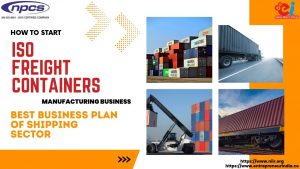
Representatives from several nations make up the International Body for Standardization (ISO), an autonomous, non-governmental organization. They are in charge of choosing the standards that the International Standards Organization will follow. This covers a wide range of facets of our daily life, such as trade, construction laws, and nutritional standards. The ISO freight container is one norm they’ve set. The size and design of the container used to carry products internationally are specified by this standard. The general purpose container and the specialized or so-called dry container are the two primary categories of containers. The majority of commodities can be transported in a general-purpose container, however goods that need particular temperature control, including fresh produce or frozen meat products, can be transported in a dry or refrigerated container.
Visit this Page for More Information: Start a Business in Shipping Container Industry
Uses and Applications:
International shipping of products uses ISO containers. Because it satisfies the International Standards Organization’s (ISO) requirements for size and strength, this kind of container is excellent for transportation. They can be as big or tiny as desired, but they are typically composed of steel and are 20 feet long by 8 feet wide and 8 feet high. In order to help secure the load, they frequently have a door on one end and a dead-man handle on top.
Then, to make them simpler to carry by boat or truck, these containers can be piled one over the other. Iso boxes have a number of benefits over other kinds of transportation, such as lower costs, simplicity of usage, and speedy loading and unloading of cargo.
Related Business Plan: ISO Freight Containers
Manufacturing Process:
Cutting the steel from a steel sheet is the first step in creating a new ISO container. A computer-controlled machine bends and folds the steel pieces after they have been chopped into smaller pieces. Next, holes are made in the metal on both sides so that rivets can be added later. After each piece has been bent and folded, it is then joined together using specialized welding machinery that places each piece precisely where it should be. After drilling the holes for the lock pins and locks, protective paint is applied. Two rows of big bolts are finally drilled through both metal sheets to seal off one end of the cargo box.
Read Similar Articles: IRON AND STEEL PROJECTS
Benefits of Starting ISO Freight Containers:
Starting a business with ISO freight containers has several advantages. This low-cost business model is ideal for small business owners who want to expand their home-based enterprises into larger enterprises. Additionally, it is a scalable business that may grow as you bring in more revenue and recruit more staff. This type of business requires little investment to get off the ground because it makes use of resources like ISO freight containers that are already in circulation.
Download PDF: Business Plan of ISO Freight Containers Manufacturing
There is no immediate requirement to buy land or equipment. Since the container was previously employed for shipping or trucking goods, there aren’t many risks associated with beginning an ISO Freight Container Business. You could even be able to get your ISO freight container for less in some circumstances. They are simpler to acquire room for than traditional warehouses because they may readily fit on any typical lot or construction site. When thinking about beginning your own business, the ISO freight container is one of the greatest solutions because of these features.
Market Size in India:
By 2028, it is projected that India’s container market would be worth US$10.3 billion, expanding at a 1.7% compound yearly growth rate (CAGR). A boost in maritime trade spurred on by new international trade agreements is responsible for the expansion. The growth of the e-commerce sector, the digitization of container transportation, and the increasing need for specialized containers are all expected to contribute to the market’s continued expansion throughout the course of the projected period. Furthermore, it is anticipated that quickening urbanization and rising commodity demand will fuel market expansion. It is anticipated that significant advancements in commercial ships and innovation in cargo ships outfitted with the newest technologies, such as navigational systems, cutting-edge sensors, and other components, will boost demand for transportation and, in turn, fuel the growth of the container market.
Related Feasibility Study Reports: Start Business Of Manufacturing Iso Freight Containers
Global Market Outlook:
The vast majority of cargo are transported in large shipping containers, sometimes referred to as ISO shipping containers, which are made of various steel grades. The containers are transported by land, rail, and water. Similar size requirements apply to ISO shipping container production. Several containers were created after the ISO specification standards were adopted. Over categories like refrigerated containers and standard dry containers, the different sizes of these shipping containers remain 40′, 20′, and 10′. By 2030, the market for shipping containers is projected to be worth USD 9,700 billion, with a CAGR of 4.30%. Over the course of the projection period, there should be a moderate growth in the market for ISO shipping containers. Increased commodity demand, industrial growth, and the growing use of shipping containers in seaborne trade are all factors that have an impact on market expansion.
Click here to send your queries/Contact Us
See More Links:
- Start a Business in Asia
- Start a Business in Potential Countries for Doing Business
- Best Industry for Doing Business
- Business Ideas with Low, Medium & High Investment
- Looking for Most Demandable Business Ideas for Startups
- Startup Consulting Services
- Start a Business in Africa
- Start a Business in India
- Start a Business in Middle East
- Related Videos
- Related Books
- Related Projects
- Related Market Research Reports